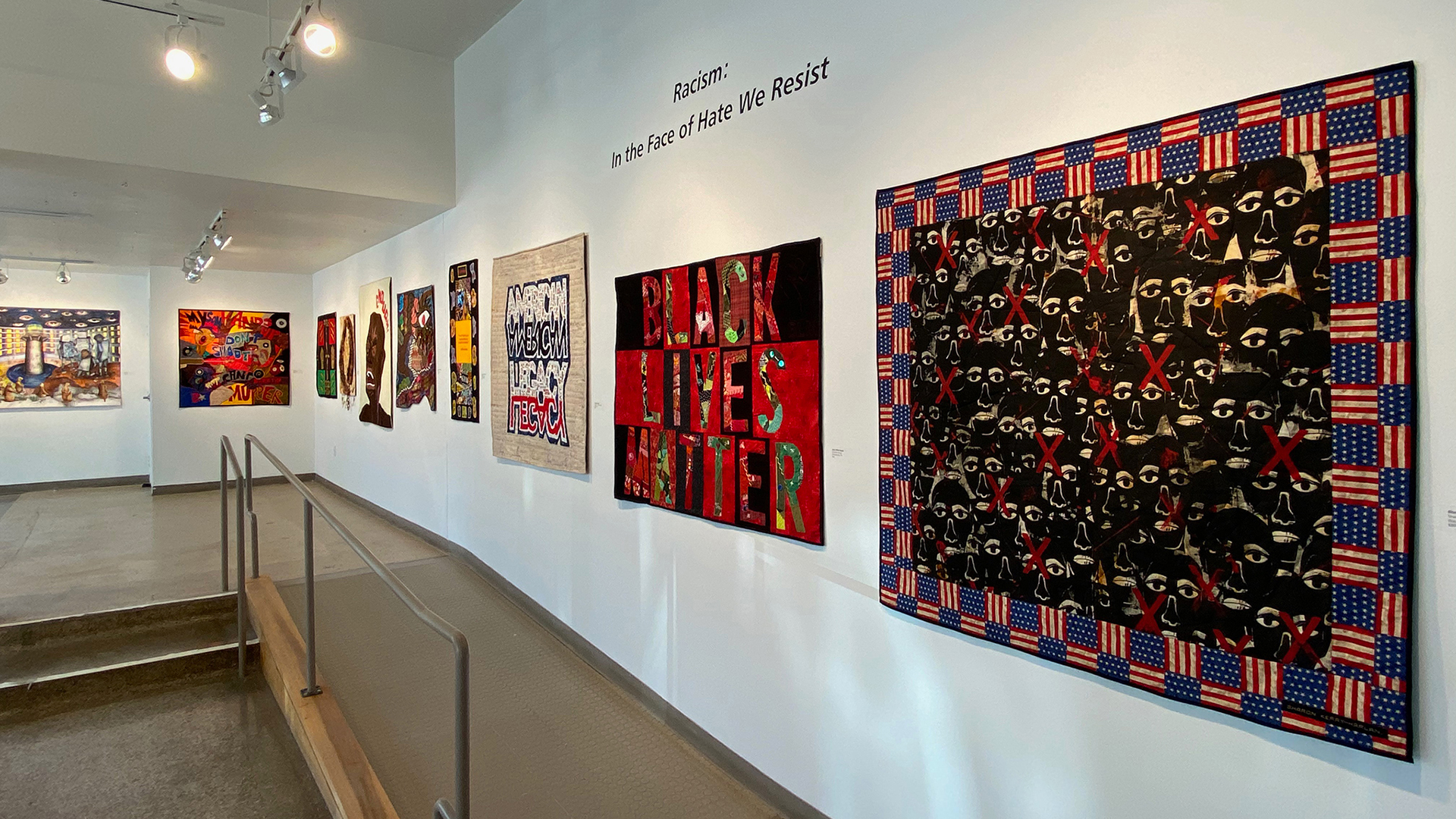Q&A: Dr. Carolyn L. Mazloomi, Curator of ‘Racism: In the Face of Hate We Resist’ Quilt Exhibit
August 23, 2021 Leave a Comment
“Racism: In the Face of Hate We Resist” is an international juried exhibit of 63 quilts sharing stories of resistance and fortitude that have been integral to the survival of Black people in America. It will be available during the 2021 virtual Great Wisconsin Quilt Show, Sept. 9-11 at quiltshow.com.
This powerful exhibit is part of the Textile Center and Women of Color Quilters Network’s “We Are the Story” initiative.
PBS Wisconsin spoke with curator Carolyn L. Mazloomi about how this exhibition came together, its impact and how she sees the art world opening up to quilters and Black artists.
[The following interview has been edited for clarity and brevity]
PBS Wisconsin: How did this exhibition come together?
Dr. Carolyn L. Mazloomi: I watched the news cast which had a video of George Floyd being murdered, and it was gut-wrenching. For me as a mother, when I heard him call out for his mother knowing that his death was near, it was like a clarion call to me. I felt that I had to do something to call attention to racism and police brutality, and as a curator, the first thing I think about is an art show. So, I called the director of Textile Center and asked for his help in finding venues, and I curated seven exhibitions that opened around the Minneapolis area.
The two juried exhibitions I put out a call for, I was really surprised because people around the world responded. And the one commonality that we had was the fact that as people of color, we all experienced racism in some form or fashion. People in Italy and England, Brazil, Japan, these artists told me that my story is their story as a person of color living in a country outside the United States. So, it just goes to show how the murder of George Floyd resonated around the world. Not only with people of color, but all people that are interested in equality and fairness of justice.
It was important for me to have those quilts displayed with the stories that people had to tell about their experiences and the harshness and unfairness of racism and police brutality, as well as a show to commemorate those people that have been killed by the police over the past decades, not only recently, but historically as well.
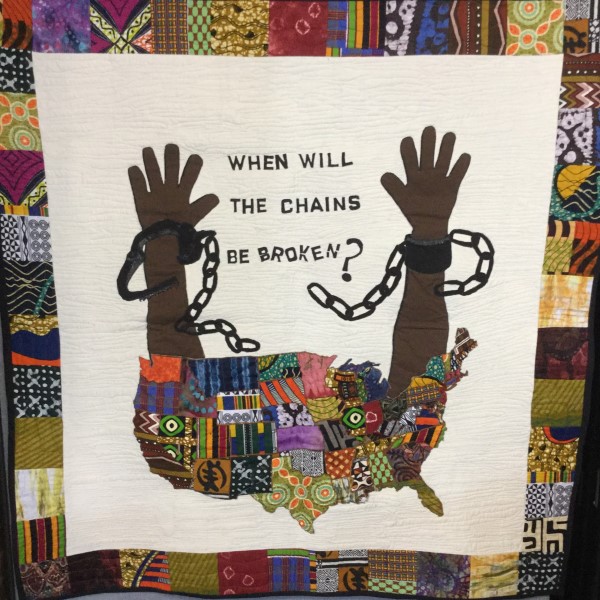
“When Will the Chains Be Broken?” by Mary D. Pinckney of Warrensville Heights, Ohio
PBS Wisconsin: What makes quilting a compelling artform to convey these challenging themes?
Dr. Mazloomi: The familiarity of the cloth — that’s the first thing. I often say as human beings we have a lifelong affair, especially here in this country, with the cloth. It’s the first thing we’re swathed in at birth. It’s the last thing that touches our bodies on our death. So, why not use this familiar material to create art? That you’re already familiar with, so we’re just giving you difficult subjects to tackle and look at.
Another one of the purposes of putting together these exhibitions is so people come and they can have a conversation in a safe place, in a museum or art center, about these difficult topics. This is a good thing to bring people together, so we’re using art to do that. And it’s about race and reconciliation.
PBS Wisconsin: Do you have a favorite piece in the show?
Dr. Mazloomi: There’s so many. There’s so many! I can’t really say that I have a favorite because as a curator, I don’t necessarily look at technique, I look at story. I curate for storyline, and all the stories are relevant. All of the stories have historic value.
Quilts are like cultural documents. You have people all over the world who study quilts. So, hundreds of years from now people will be looking at the quilts made today. They get a glimpse into the timbre of the times, what was happening in our country, our families, our communities, our churches and with the individual quilter. So this is why I say they’re cultural documents that tell the story of not only the individual maker, but our country — that’s important. People have to know each quilt documents a story.
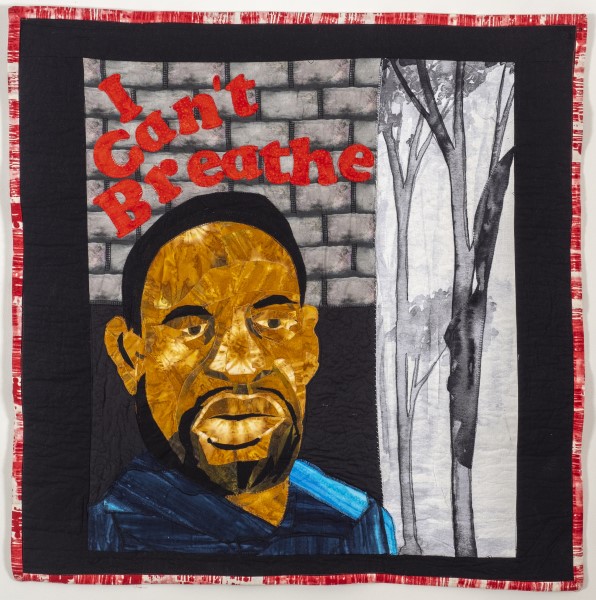
“Breath” by Peggie Hartwell of Summerville, South Carolina
PBS Wisconsin: What kind of feedback have you received from the exhibition?
Dr. Mazloomi: They are either on one side of the fence or the other. First of all, I get a lot of hate mail from people who are upset for various reasons. Then I get mail that’s really positive and welcoming, people from outside of the culture saying that they’re intrigued by the history that they’ve seen in the quilts and the stories that they tell because they were stories that they were unfamiliar with. It was eye opening for them to learn about this history because they had no knowledge of it.
PBS Wisconsin: What do you hope viewers take away from this exhibit?
Dr. Mazloomi: Knowledge not only about African American history, but things that are oppressive or deemed racist towards African Americans because I think people don’t understand.
I often identify myself as an elder African American woman born and raised in the Jim Crow segregated South. We as Black folk growing up in my time, we had to learn history, but it was white history. We weren’t in the history books. So, we have this knowledge overall about white people and their history, but white people don’t know that much about African American history.
So that’s another role that these quilts play, to let people from outside of the culture know that we participated in activities in this country, building the country at every strata that you can think of. That’s portrayed in some of the quilts, that knowledge people from outside Black culture did not know. So I get letters saying it’s interesting, these stories, that they did not know. They help people from outside of the culture see Black folks in a different light, in a different way.
The viewer sees this history from our perspective, directly. Hearing in our voice all these transgressions that have happened to us, and our hopes for the future without racism, a future where communities and people and nations are united and seen as being Americans, not just Black or white or Hispanic or other. We’re one nation.
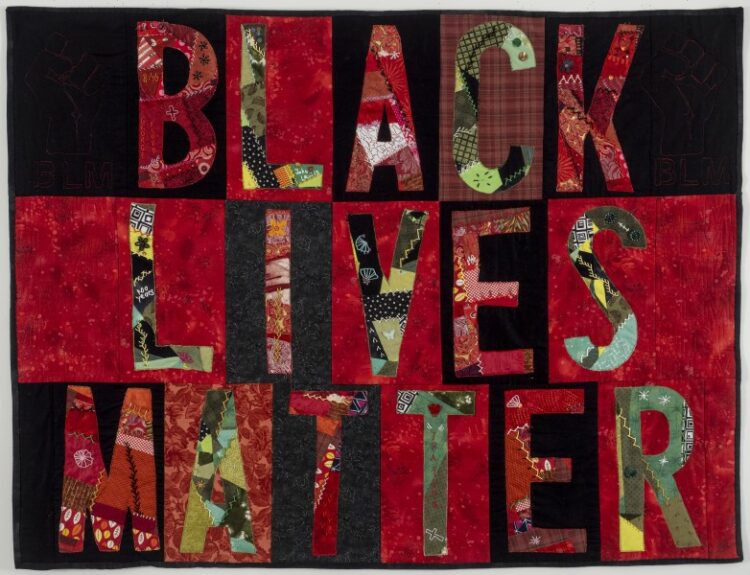
“Dear White People” by Michelle Flamer of Philadelphia, Pennsylvania
PBS Wisconsin: I understand your professional background is not in fiber arts or quilting.
Dr. Mazloomi: (Laughs) No, it’s not. Formally, I was an aircraft engineer. That was 50 years ago, so it’s a new day. But yes, that’s my formal profession. And my husband’s in the same field. And even now I say, I love my family — I’m a mother first, and I’m a wife — but then I love airplanes, and I love quilts.
That’s the beauty of living in the country that we live in. We’re free to do whatever we want to do, and involve ourselves, fortunately in the things that we love. And I believe that we as human beings should be involved in occupations that we love. So, we’re fortunate to live in a country where we can do that, you know? If we want to change or add to our vocations, we are free to do that. And I have always done that. So, I often say I’ve lived many lives, and I’ve enjoyed each one of them.
PBS Wisconsin: What was your introduction to quilting?
Dr. Mazloomi: I happened to be in Dallas, Texas, at the International Trade Market. I was there to buy gifts for a store that I had at the time. I saw in a dealer’s showroom a quilt made by a cooperative in Kentucky. And it was at a time when quilt cooperatives were popular here in the United States, and I was just drawn to that quilt. It was a traditional patchwork quilt, and then in each corner it had an appliqué eagle.
Like most quilters, we’re guilty, you wanna go and touch the quilt. So I couldn’t wait for the dealer to turn his back so I could touch the quilt and look at the other side of the quilt to see the stitching and whatnot. But I was in love with that quilt, and I was living in California at the time. I went back to California determined to teach myself how to quilt.
I am a self-taught quilter. I went and got a how-to book, and I taught myself. So over the decades, I evolved from that simple 9-patch quilt that I made to doing what I do now: wholecloth quilts that are painted and printed and stamped. I’m one that uses all the technology as well to make quilts, and I love it. And I’m always waiting for the next big thing on the horizon and for new techniques and materials to use in my quilts. In essence, I’m a self-taught quilt-maker.
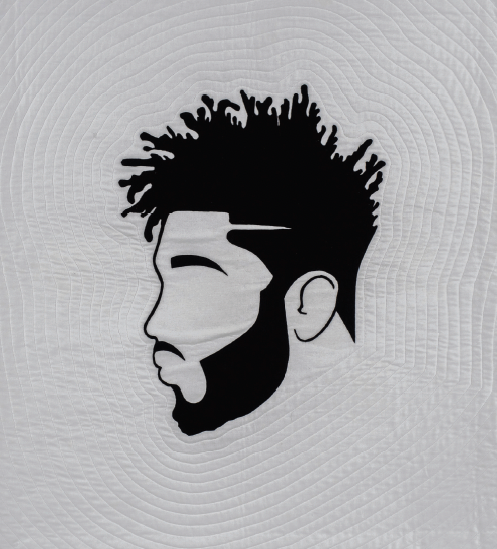
“Man with Locs (Handsome)” by Jeanette Floyd of Lake Forest, California
PBS Wisconsin: How old would you say you were when you found that quilt in Dallas?
Dr. Mazloomi: Over 45. You’re never too old to learn. I’m still learning and always seeking new adventures whether they be artistic or otherwise. Now I want to learn how to sculpt, and I’m going to do that. I’m always off to the next best thing in my own mind. This is the privilege of living a long life: We get to do all these activities that we imagine in our minds that we want to do.
PBS Wisconsin: How did you become a curator?
Dr. Mazloomi: Well, I founded the Women of Color Quilters Network. It’s been almost 40 years, and the objective of the network is to preserve and educate and display quilts made by African Americans. And within that perspective, I started curating quilts for the Women of Color Quilters Network. I curate all of our exhibitions, and I’ve done that for 40 years. And we’ve been very fortunate. We’ve shown at some of the most important museums here in this country and abroad. So, it’s been a wonderful, extraordinary 40 years with this organization.
PBS Wisconsin: From your perspective has quilting become more popular or more niched in recent years?
Dr. Mazloomi: Oh my goodness. Decades ago, I said that quilts have jumped off the bed onto the wall, and now they are seen as works of art. We have quilters that have come through the Network at one time in their career, they’re now represented by some of the country’s best art galleries, and their quilts are being purchased by museums and collectors not only here but around the world.
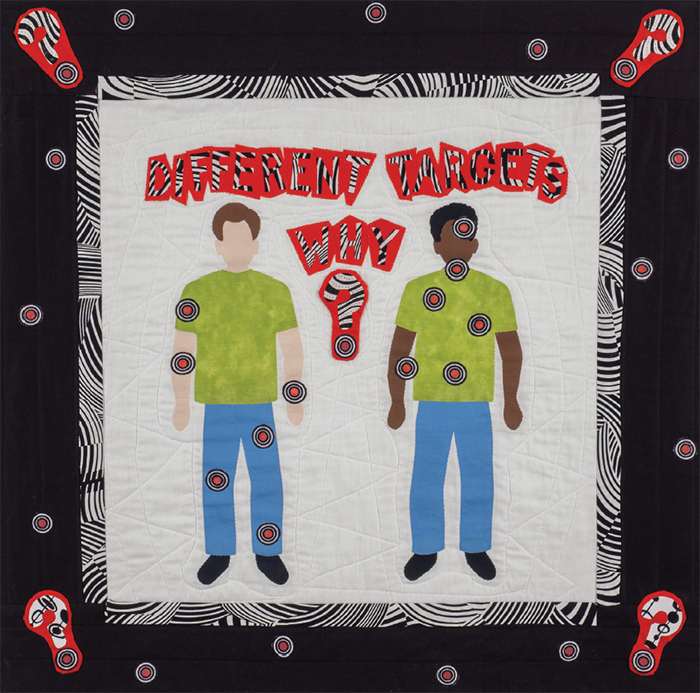
“Different Targets … Why?” by Marjorie Diggs Freeman of Durham, North Carolina
PBS Wisconsin: As a curator, how have you seen the quilting world evolve for Black artists?
Dr. Mazloomi: I feel that African American artists are really in a place not unlike the Harlem Renaissance, where the artists are being sought out and quilts are being sought out. You only have to look at the quilts by Bisa Butler who’s one of the most popular fiber artists not only in America, but around the world. You have to look at Faith Ringgold. The quilts are collectible, and they’re sought after. And quilters are getting substantial money for their work.
There are a lot of African American quilters, but we’re like a fraction of one percent of the quilting population. So in that sense, the quilts are rare. We don’t have that many professional artists that are selling their quilts. Most African American quilters are hobbyists. They make quilts for themselves and their families. They don’t care if you ever see them or not! Therefore, the ones that are selling the quilts are popular. So it’s a good time for African American art regardless of the discipline, regardless of the medium. It’s just hot. We’ve arrived. I’m hoping everybody enjoys the bandwagon before it disappears because these things come in waves.
Textile Center Women of Color Quilters Network Racism: In the Face of Hate We Resist Dr. Carolyn Mazloomi virtual quilt show Antiracism Black Lives Matter Great Wisconsin Quilt Show 2021 quilt exhibits
 Passport
Passport




